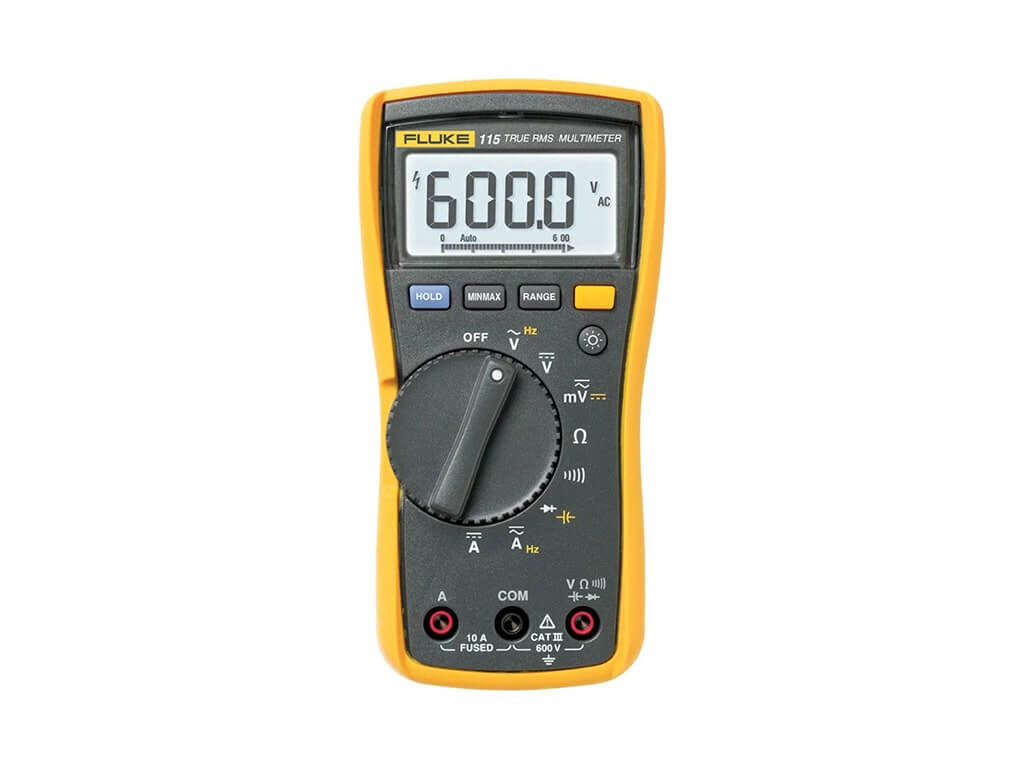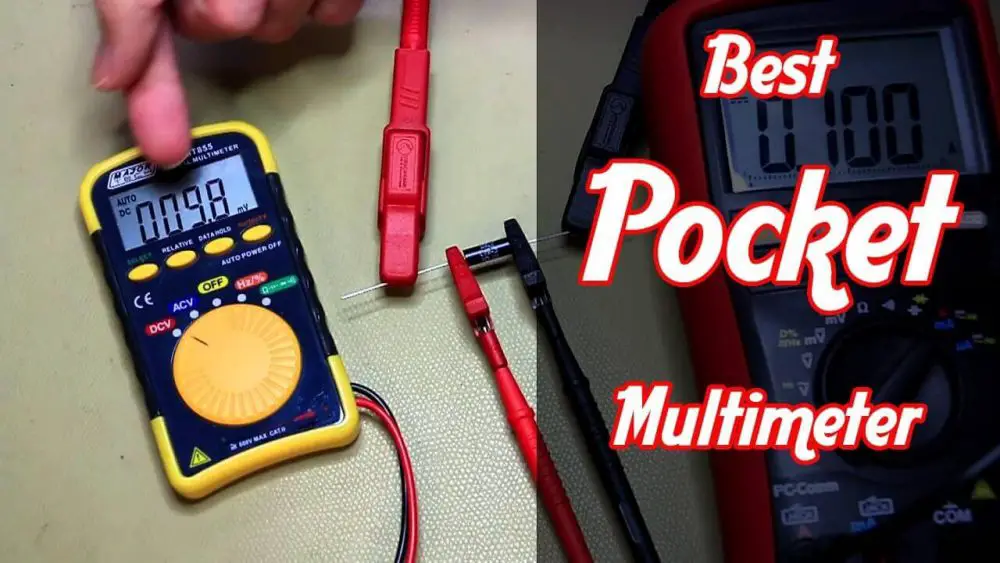Best Fluke 115 Compact True-RMS Digital Multimeter
This is a True RMS multimeter. Although it is a very basic multimeter, I certainly feel the excellent solid and robust plastic body is good and safe to use with a back stand. However, it is quite an expensive multimeter of 6000 counts that do not have milliamps or microamps selection. This works for electronic and electrical appliances.
What’s in the box:
- Fluke 115 Compact True-RMS Digital Multimeter
- Holster
- 9V battery
- 4mm silicone test leads
- Manual
Table of Contents
Quick Review
- Fluke 115 is a True-RMS for accurate measurements of direct and indirect voltage.
- CAT III safety rated 600 V.
- Temperature check
- Check continuity, frequency, capacitance and diode test.
- Large white LED backlight to work in darker areas.
- Maximum voltage A/C & D/C record 600 volts.
- Min/ Max/ Average button to record signal fluctuations.
- A/C & D/C voltage measurements up to 10 amps.
Fluke 115 Multimeter External Features
It has to be solid feeling quality in hand; plastic is an adorable selector switch. It does have a close solid yellow colour external boot housing. It is a True RMS. It has a hold button, a min-max, average to double-check manual range switch yellow button for the second functions for some of the selections. And it does have a backlight. And it does have an excellent standing bail.
At the bottom, you have three inputs; one is common, Voltage, continuity, resistance, diode, and current. But one thing is negative which is missing; milliamps and microamps.
The display is a lovely addition, the size digit with nice solid glass on it. Backlight is certainly brighter in a darker place. The leads are reasonable, no complaints about the rubbery quality, friendly feelings in the hand, impressed by Fluke leads, 1000 CAT volt. Lovely to hold in hand nice pointed in the end. The probe ends are also of good quality. Jack ports are also of perfect quality.
Fluke 115 Multimeter Functions
Voltage Test
Let’s turn the dial more and select the voltage. Smooth presentation of the bar graph, and it can read up to 6000 counts. So our voltage is 29.71 volts. We will press the manual range and let us see what will be the reading! So no complaint with the overshoot; we have got the same readings on the multimeter screen that is 29.71 volts.
Accuracy Test
Next, we are checking the accuracy. I have connected the multimeter to the Pin tray ( in this pin tray, we have all calculated voltages readings to check the accuracy of our multimeter). Our selector dial must be defaulted to on D/C volts; when we press the yellow button, it will show AC millivolts press again to default it to D/C millivolts. Our reading is 250.1 volts. In the pin tray, it is already mentioned 250.0, which means the multimeter is accurate.
We are checking it and the results of Fluke 115 are specs for A/C volts; the specified reading is 4.999, still well-specified. Reading spec for A/C volts is 1%. So it can afford the reading flicker up to 1%, which is highly acceptable.
Frequency Test
Frequency is our next check. Our selector is on A/C volts; Again, we push the yellow button to check frequency in hertz. Given hertz is 9.995 hertz and our Fluke 115 reading is 9.999hertz. We have checked different frequencies, and I am very impressed with very perfect, quick resolution while taking inconsistent readings.
D/C current test
Next, we are going to measure D/C current milliamp. We have 0.001 milliamps here. Our selection dial we will move to Amps. And the display screen is showing 0.001 milliamps, no further resolution on. So the ability to measure on milliamps should be on a current selector.
A/C current Test
Just go to the A/C side, move the selector dial to the A/C. 0.1 amps are our A/C amps.
We are about to check the resistance here, move the dial selector to Ohms, now we will touch both the pointed ends of the leads. There is a reading of 0.1 Ohms resistance of the leads.
Diode Test
Next, we will do a diode test; the specification we have here can check up to 2 volts. We will take a simple diode. We recall a shock diode. The reading we observed is 0.148, which is very low.
Next, we will check a red LED., and I will show a drop across the 1.765, green LED again 1.781, and the blue LED that is unable to record display screen shows OL’. So now we will take another multimeter and check the blue LED.
Capacitance Test
Next, we are going to check the capacitance measurements in different ranges. First, a 2.2 nano farad capacitor let us check the meter reading on the screen. The screen is a flickering resolution between 2 and 3, which is fair enough to measure—an electrolytic of 1 microfarad that comes up on the screen 990 Nanos. Next, I have the 15 microfarad capacitor. Multimeter displays 15.4 mF. We have another electrolytic of 1000 microfarads, of which we measure 996 mF. Here we have one more prominent fellow, capacitance 4600 mF, and here we have a reading of 4603 on Fluke 115 screen.
Read more: Fluke 88 V/A Automotive Multimeter Review
Continuity Test
Now we move our dial to continuity, we will touch both the leads, and we can hear a continuous buzzer. So it certainly a latched continuity buzzer works very well and quickly.
Minimum-maximum-Average Check
Now I click on the minimum-maximum button. The first reading is max, you hear beeps, and it is recording down, and if I push the min-max button again, we have a minimum reading. And press the min-max button again. It will give you an average reading with time which is a handy feature of the multimeter. If you click it again, you can see your live reading, which you previously worked on.
THING I LIKE ABOUT IT
Portable polyester protective case
Compact and lightweight
Larger display
Reliable and accurate
THINGS I DIDN’T LIKE
No microamps
little bit Expensive
Frequently Asked Questions
No, you cannot check the temperature with F 115, whether you have temperature testing probes. This multimeter does not have the temperature test option.
No, Fluke is friendly and reliable, Easy in handling, rugged, robust and accurate—the name you can trust.
Conclusion
Fluke 115 digital multimeter does have the excellent build quality, body protection and safety. Everything is perfect to me. However, the clarity of the digits are not very good like other flukes, and as we discussed, this fluke does not have milliamps and microamps. So overall, it is a reasonable multimeter except for some negative downsides, user friendly, easy to use and accurate.
Related posts:
Fluke 113 True-RMS Utility Multimeter Review
Fluke 114 Digital Multimeter With TRMS For Electricians Review





![10 Best multimeter for the money – Top Picks & Reviews [2022] best multimeter for the money](https://multimetertools.com/wp-content/uploads/2021/03/best-multimeter-for-the-money-1-1-1-1-1-1.jpg)